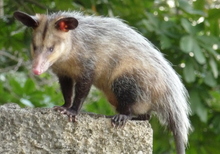For horse owners, optimal equine health is everything. Whether a horse has a rigorous competition schedule, is a working ranch horse or is used for pleasure, day-to-day well-being is a top priority.

An oppossum - Primary parasite host
Some equine diseases show clear clinical signs and are easy to identify, but others can be subtle and are not immediately recognizable. One such disease is equine protozoal myeloencephalitis.
© 2015 by Wolfman
One of the best ways to help protect a horse and maintain good overall health is to learn about equine diseases, which can cause both short- and long-term problems for horses and their owners.
Some equine diseases show clear clinical signs and are easy to identify. But others can be subtle and are not immediately recognizable. One such disease is equine protozoal myeloencephalitis (EPM), a neurological disease that can cause distress in both the horse and the horse owner.
âEPM can be tough to diagnose and cause real problems for the horses that contract it,â says Megan Green, DVM, manager, Merial Large Animal Veterinary Services. âBecause EPM is a potentially fatal neurological disease, itâs important that horse owners learn about its causes and clinical signs so they are better prepared to recognize it.â
What is EPM?
EPM is a neurological disease found in horses caused by Sarcocystis neurona, a parasite that attacks the brain and spinal cord. It is a disease that, if not detected and treated, can seriously damage a horseâs central nervous system and can even lead to death.1,2
How does a horse get EPM?
Opossums are the primary parasite hosts. Horses can become infected with EPM by coming into contact with opossum feces while out grazing or by ingesting feed contaminated by a carrying opossum.1 Horses cannot pass the disease to one another, so thereâs no need to isolate a horse out of fear of spreading the disease.
Some horses are more at-risk than others, though â horses younger than five years of age and those older than 13.3 EPM cases are also more likely to appear in the spring, summer or fall.3 Stressful events and activities, such as traveling or training, can also compromise a horseâs immune system and activate the disease.4
What are the clinical signs of EPM?
Many signs of EPM mimic those of other equine disorders that affect the central nervous system, such as wobbler syndrome, rabies, West Nile virus, equine herpesvirus and equine motor neuron disease.
Clinical signs of EPM range from extremely subtle to severe. Subtle signs can include mild depression, gait abnormalities and irregular upper airway function. If severe, a horse might exhibit ataxia, muscle atrophy, recumbency, seizures, stumbling or other brain stem signs.
Is EPM preventable?
There is no vaccine currently available to prevent EPM, but the best way to remain EPM-free is to work to keep opossums and other unwanted animals away from horses. For instance, horse owners can cover exposed grain, empty trash cans, rid their properties of animal carcasses and keep water tanks clean.
How should I treat my horse if it is diagnosed with EPM?
MARQUIS® (15% w/w ponazuril) Antiprotozoal Oral Paste is the first FDA-approved treatment for EPM. It has been proven to cross the horseâs brain barrier and successfully kill S. neurona, the parasite opossums may host.5 If treated quickly and properly, horses can recover from EPM. The earlier treatment begins, the better the expected outcome.6 Most horses show the most significant improvement within the first four weeks of treatment.6
Learn more about EPM and MARQUIS by consulting your veterinarian and visiting MARQUIS.merial.com.
IMPORTANT SAFETY INFORMATION: The safe use of MARQUIS in horses used for breeding purposes, during pregnancy, or in lactating mares, has not been evaluated. In animal safety studies, loose feces, sporadic inappetence, lost weight, and moderate edema in the uterine epithelium were observed.
®MARQUIS is a registered trademark of Merial. ©2015 Merial, Inc., Duluth, GA. All rights reserved. EQUIOMQ1509 (05/15)
About Merial
Merial is a world-leading, innovation-driven animal health company, providing a comprehensive range of products to enhance the health and well-being of a wide range of animals. Merial employs 6,100 people and operates in more than 150 countries worldwide with more than â¬2 billion of sales in 2014. Merial is a Sanofi company. For more information, please see www.merial.com.
1Reed S. Neurology is not a Euphemism for Necropsy: A Review of Selected Neurological Diseases affecting horses; AAEP Proceedings. 2008;54:78-109.
2The Merck Veterinary Manual. Overview of Equine Protozoal Myeloencephalitis. Available at: http://www.merckvetmanual.com/mvm/nervous_system/equine_protozoal_myeloencephalitis/overview_of_equine_protozoal_myeloencephalitis.html. Accessed March 3, 2015.
3Saville WJ, Reed SM, Morley PS, et al. Analysis of risk factors for the development of equine protozoal myeloencephalitis in horses. J Am Vet Med Assoc. 2000;217:1174-1180.
4Saville WJ, et al. Utilization of stress in the development of an equine model for equine protozoal myeloencephalitis, Vet Parasitol. 2001;95:211-222.
5Furr M, Kennedy T. Cerebrospinal fluid and serum concentrations of ponazuril in horses; Veterinary Ther. 2001;2(3):232-237.
6McCoy A. Equine protozoal myeloencephalitis. University of Minnesota Extension. Available at: http://www.extension.umn.edu/agriculture/horse/health/equine-protozoal-myeloencephalitis/. Accessed February 17, 2015.
